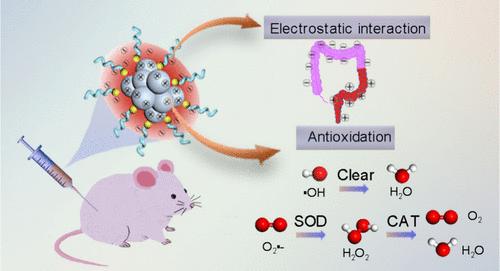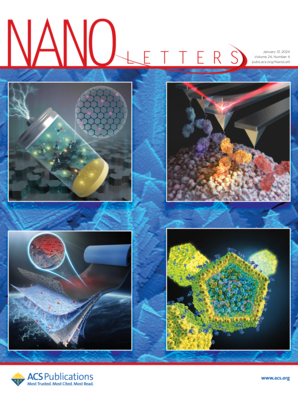Ligand-Targeted Ag9 Cluster Self-Cascade Antioxidants for Enhanced Reactive Oxygen Species Clearance in the Treatment of Inflammatory Bowel Disease
IF 9.6
1区 材料科学
Q1 CHEMISTRY, MULTIDISCIPLINARY
引用次数: 0
Abstract
Atomically precise metal nanoclusters (MNCs) with flexible peripheral ligands provide selective channels and unique electronic structures to the rigid metal core, showing great application potential in many fields such as biomimetic nanozymes. In this study, we developed cost-effective, low-toxicity, and water-soluble MNC based self-cascade antioxidants for enhanced reactive oxygen species clearance. Compared to Ag nanoparticles, the Ag9 NCs with a monovalent Ag core coordinated by nonmetallic S and O show superior superoxide dismutase-like (inhibition 86.7%) and catalase-like (Km = 20.37 mM, Vmax = 3.13 × 10–3 mM s–1) activities. Interestingly, the −COOH groups on the ligands endow Ag9 NCs with a −42.5 mV negative surface charge, enhancing the targeting to inflammatory cells. Additionally, Ag9 NCs’ remarkable therapeutic effects have been confirmed in cell cultures and an inflammatory bowel disease (IBD) model. Thus, this study proposes a novel cluster-based nanozyme that utilizes ligands for targeting and monovalent metal cores for catalysis, demonstrating significant therapeutic potential for IBD treatment.

求助全文
约1分钟内获得全文
求助全文
来源期刊

Nano Letters
工程技术-材料科学:综合
CiteScore
16.80
自引率
2.80%
发文量
1182
审稿时长
1.4 months
期刊介绍:
Nano Letters serves as a dynamic platform for promptly disseminating original results in fundamental, applied, and emerging research across all facets of nanoscience and nanotechnology. A pivotal criterion for inclusion within Nano Letters is the convergence of at least two different areas or disciplines, ensuring a rich interdisciplinary scope. The journal is dedicated to fostering exploration in diverse areas, including:
- Experimental and theoretical findings on physical, chemical, and biological phenomena at the nanoscale
- Synthesis, characterization, and processing of organic, inorganic, polymer, and hybrid nanomaterials through physical, chemical, and biological methodologies
- Modeling and simulation of synthetic, assembly, and interaction processes
- Realization of integrated nanostructures and nano-engineered devices exhibiting advanced performance
- Applications of nanoscale materials in living and environmental systems
Nano Letters is committed to advancing and showcasing groundbreaking research that intersects various domains, fostering innovation and collaboration in the ever-evolving field of nanoscience and nanotechnology.
 求助内容:
求助内容: 应助结果提醒方式:
应助结果提醒方式:


